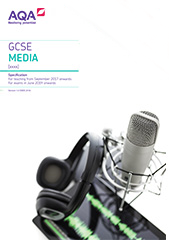3.4 Media language
Students should have knowledge and understanding of how the media, through their forms, codes and conventions, communicate meanings.
Students will be required to demonstrate knowledge and understanding of how media products reflect the social, cultural, historical and political contexts in which they are produced. Not every question in every exam series will require the analysis of the four contexts but students will need to be familiar with all of them in relation to a range of media products.
In the following table, the column headed Content includes the mandatory material which all students should study. The column headed Guidance Notes includes pointers and suggestions to help schools and colleges interpret and deliver the content where these are appropriate. These Guidance Notes will be supplemented by further support materials (the CSP booklet).
Forms of media language
|
Content |
Guidance notes |
|---|---|
|
Fundamental principles of semiotic analysis, including connotation and denotation. |
Other terms and techniques may include:
|
|
The various forms of media language used to create and communicate meanings in media products. |
Linear models of communication:
|
Choice of media language
| Content | Guidance notes |
|---|---|
| How choice (selection, combination and exclusion) of elements of media language influences meaning in media products to create narratives, to portray aspects of reality, to construct points of view, and to represent the world in ways that convey messages and values. | The ‘rules’ of media language: how signs are selected, deselected and assembled to conform to codes and make meanings. Register and modes of address.
The constructed nature of reality. |
Theories of narrative
|
Content |
Guidance notes |
|---|---|
|
Theories of narrative, including those derived from Propp (character types). |
Narrative development:
Audience appeal of narrative:
|
Technology and media products
|
Content |
Guidance notes |
|---|---|
|
The relationship between technology and media products. |
How developments in technology impact on content:
|
Codes and conventions
| Content | Guidance notes |
|---|---|
| The codes and conventions of media language, how they develop and become established as ‘styles’ or genres (which are common across different media products) and how they may also vary over time. | Varieties of code. Technical codes: moving image and photographic:
Print codes: design, layout and typography
Symbolic codes
Verbal and non-verbal codes
|
Theoretical perspectives on genre:
Intertextuality, including how inter-relationships between different media products can influence meaning. | The evolution and development of genres (including hybrid genres) in different media forms. Factors influencing the creation of genre products:
|
